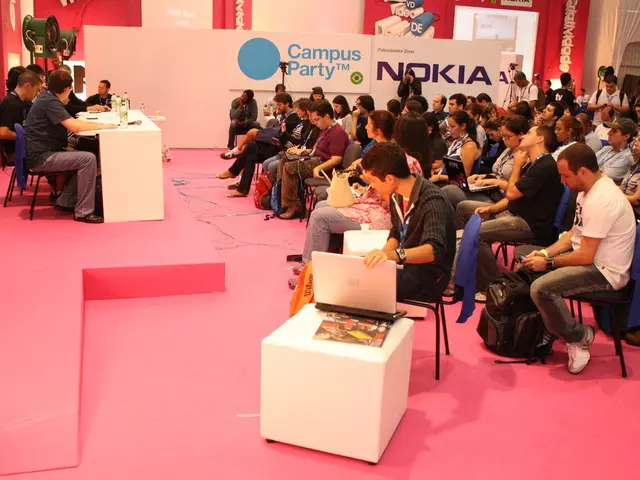Collaborative debut: Oura and Dexcom introduce glucose monitoring integration
Oura and Dexcom Unveil Glucose Tracking for Enhanced Wellness Management
In a significant leap forward for wearable health technology, Oura Health and Dexcom have partnered to introduce glucose tracking. This collaboration combines Oura's personal health monitoring capabilities with Dexcom's newly developed Stelo continuous glucose monitor (CGM) specifically designed for non-diabetics. The integration aims to deliver real-time, personalized insights that link glucose levels with sleep, workout patterns, and lifestyle habits, helping users seize control of their wellness by leveraging connected data.
Key Points
- Oura Ring now synchronizes with Dexcom Stelo CGM, offering a blend of metabolic and wellness metrics.
- This integration caters to non-diabetic users who want to enhance their metabolic health using FDA-cleared tools.
- The alliance reflects a growing curiosity regarding glucose tracking as a facet of everyday health management.
- Medical experts harbor cautious optimism but emphasize the importance of responsible glucose data interpretation.
Suggested Further Reading: Wearables and AI in Real-Time Health Tracking
Table of Contents
- Oura and Dexcom Unveil Glucose Tracking
- Key Points
- Understanding the Dexcom Stelo and Oura Integration
- Why Wearable Glucose Tracking Is a Game-Changer
- Market Growth and Consumer Demand for Metabolic Health Wearables
- Glucose Insights and Oura's Existing Features
- Expert Views on Non-Diabetic Glucose Monitoring
- Stelo vs. Other CGMs: An Analysis
- Use Case: Everyday Applications
- FAQs: Important Insights Before Utilizing Oura and Dexcom
- Is the Oura Ring compatible with glucose monitors?
- What sets Dexcom Stelo apart from other Dexcom CGMs?
- Can non-diabetics use CGMs safely?
- Privacy Concerns and Glucose Data
Understanding the Dexcom Stelo and Oura Integration
Dexcom Stelo is a CGM developed for wellness users who are not treating diabetes. Unlike Dexcom G6 or G7, which cater to diabetic patients, Stelo suits individuals interested in tracking glucose as part of a healthy lifestyle. The FDA has approved it for use by non-insulin users, despite it not being intended for medical diagnosis.
The Oura Ring already tracks metrics like sleep, readiness, and physical activity. Thanks to Dexcom integration, it now offers metabolic understanding through glucose data. Users can now discern patterns such as glucose surges following poor sleep or stressful days, leading to more informed health decisions supported by interconnected metrics.
Suggested Further Reading: AI Global Arms Race
Why Wearable Glucose Tracking Is a Game-Changer
Glucose tracking offers a fresh layer of insight into personal wellness. CGMs were once exclusive to people managing diabetes, but growing demand has shifted them into the wellness space. With heart rate variability analysis, stress assessment, and now glucose monitoring, wearables have become valuable tools for fostering behavioral change.
By translating daily routines into metabolic outcomes, users can reflect upon their dietary choices, stress levels, and exercise patterns. For example, witnessing a glucose spike after lunch followed by an afternoon dip might prompt more mindful food consumption. Continuous data feedback serves as a tool for everyday decision-making.
Market Growth and Consumer Demand for Metabolic Health Wearables
The market for wearable health technology is projected to reach $72.7 billion by 2028. Sections fast-expanding within this industry involve metabolic tracking. The partnership between Oura and Dexcom exemplifies how devices adapt to cater to this demand by providing customized insights.
Consumers are increasingly seeking data meant to induce change. Sleep and step count are now standard fare. The next frontier focuses on internal processes like glucose response, heart rate variability, and hormonal cycles. Oura and Dexcom offer a system that supports users in making evidence-based health choices by correlating multiple inputs.
Glucose Insights and Oura's Existing Features
This integration enriches each health data point with context. Rather than presenting glucose as an isolated figure, the Oura app helps users understand how it fits into broader patterns. This fosters a daily feedback loop based on numerous health markers.
- Sleep Metrics: Understand glucose fluctuations tied to poor or interrupted sleep.
- Readiness Score: Utilize glucose equilibrium to assess the body's readiness and capacity to handle stress or activity.
- Activity Patterns: Evaluate how workouts and periods of inactivity impact blood sugar rhythm.
This dynamic feedback can help users make small tweaks, such as altering the timing of an evening snack in an attempt to avoid overnight glucose surges, leading to better sleep and energy levels the following day.
Expert Views on Non-Diabetic Glucose Monitoring
Some healthcare professionals consider consumer CGMs with caution. During a public discussion, Dr. Lina Park, an endocrinologist at Boston Medical Center, addressed these concerns:
"We are in the early stages of consumer CGMs. Utilized intelligently, these devices can foster spectacular lifestyle changes. However, users must understand that CGM data can be influenced by many external factors, and interpretations should be guided by reliable metrics, not trends."
Experts recommend that not every glucose spike or drop carries medical importance. Users should be cautious when interpreting data and not use it to make drastic lifestyle changes based on normal glucose variance. These tools should cultivate mindfulness, not create anxiety.
Stelo vs. Other CGMs: An Analysis
Dexcom Stelo enters a competitive landscape with products like Levels, Ultrahuman, and Abbott Lingo. What makes Stelo unique is its FDA clearance for wellness monitoring and its seamless integration with the Oura platform.
Use Case: Everyday Applications
Consider Rebecca, a 35-year-old health enthusiast. Using the Oura Ring for years, she recently signed up for Dexcom Stelo. Within two weeks, she discovered that her typical oatmeal-based breakfast led to glucose spikes, followed by a slump in the afternoon. She opted for a high-protein meal and adjusted her workout schedule to match her glucose trends. As a result, her Oura readiness scores improved, and she reported improved focus and energy.
This instance highlights how blending data types can produce beneficial insights and highlights the value of proper context when making health-related choices.
FAQs: Questions to Know Before Utilizing Oura and Dexcom
Q: Is the Oura Ring compatible with glucose monitors?
A: Yes. The Oura app now supports synchronization with Dexcom Stelo's CGM, combining glucose readings with sleep, activity, and readiness data.
Q: What distinguishes Dexcom Stelo from other Dexcom CGMs?
A: Stelo is Dexcom's CGM marketed for wellness purposes. It excludes alarms and insulin alerts, focusing on lifestyle tracking for those without diabetes.
Q: Can non-diabetics use CGMs safely?
A: Yes. The FDA has cleared CGMs like Stelo for use by non-insulin users. However, users should interpret data judiciously and not rely on it as a substitute for medical advice.
Q: How private is my glucose data?
A: Both Dexcom and Oura employ encrypted data systems. Users decide what information to store or share with external apps.
Looking Ahead
Oura and Dexcom's collaboration signals a future where personalized, interconnected health technology becomes more commonplace. As interest in metabolic tracking expands within the wellness community, consumers will demand platforms capable of transforming raw data into actionable insights. The combination of Dexcom Stelo with the Oura Ring addresses this demand by creating a unified experience for health-conscious individuals who wish to better understand their bodies.
References
Brynjolfsson, Erik, and Andrew McAfee. The Second Machine Age: Work, Progress, and Prosperity in a Time of Brilliant Technologies. W. W. Norton & Company, 2016.
Marcus, Gary, and Ernest Davis. Rebooting AI: Building Artificial Intelligence We Can Trust. Vintage, 2019.
Russell, Stuart. Human Compatible: Artificial Intelligence and the Problem of Control. Viking, 2019.
Webb, Amy. The Big Nine: How the Tech Titans and Their Thinking Machines Could Warp Humanity. PublicAffairs, 2019.
Crevier, Daniel. AI: The Tumultuous History of the Search for Artificial Intelligence. Basic Books, 1993.
- Users can now monitor their glucose levels using the Oura Ring, as it has been synchronized with the Dexcom Stelo continuous glucose monitor (CGM).
- The Dexcom Stelo CGM is designed for non-diabetic users interested in enhancing their metabolic health using FDA-cleared tools.
- The integration of Dexcom Stelo with the Oura Ring allows for real-time, personalized insights that link glucose levels with sleep, workout patterns, and lifestyle habits.
- The collaboration between Oura and Dexcom reflects a growing interest in artificial intelligence and technology's role in health-and-wellness, fitness-and-exercise, nutrition, and wearables.








